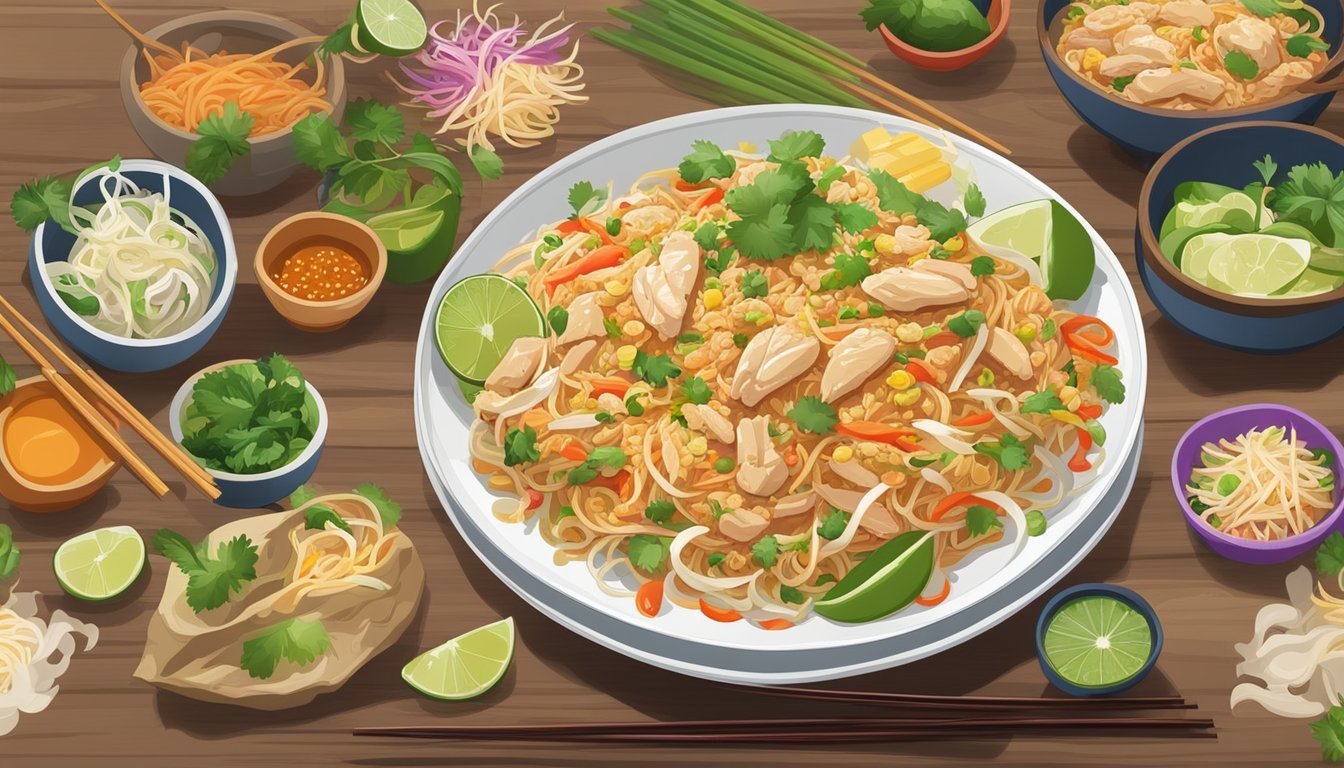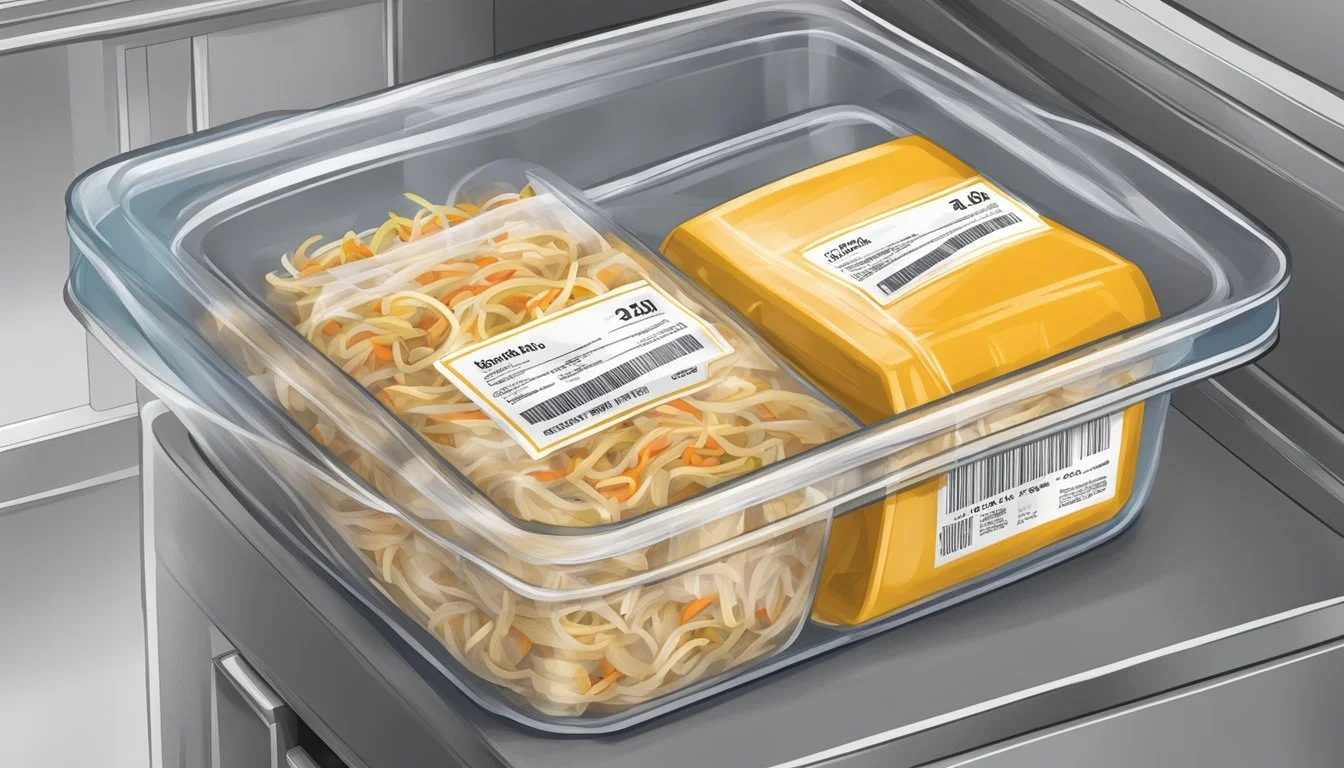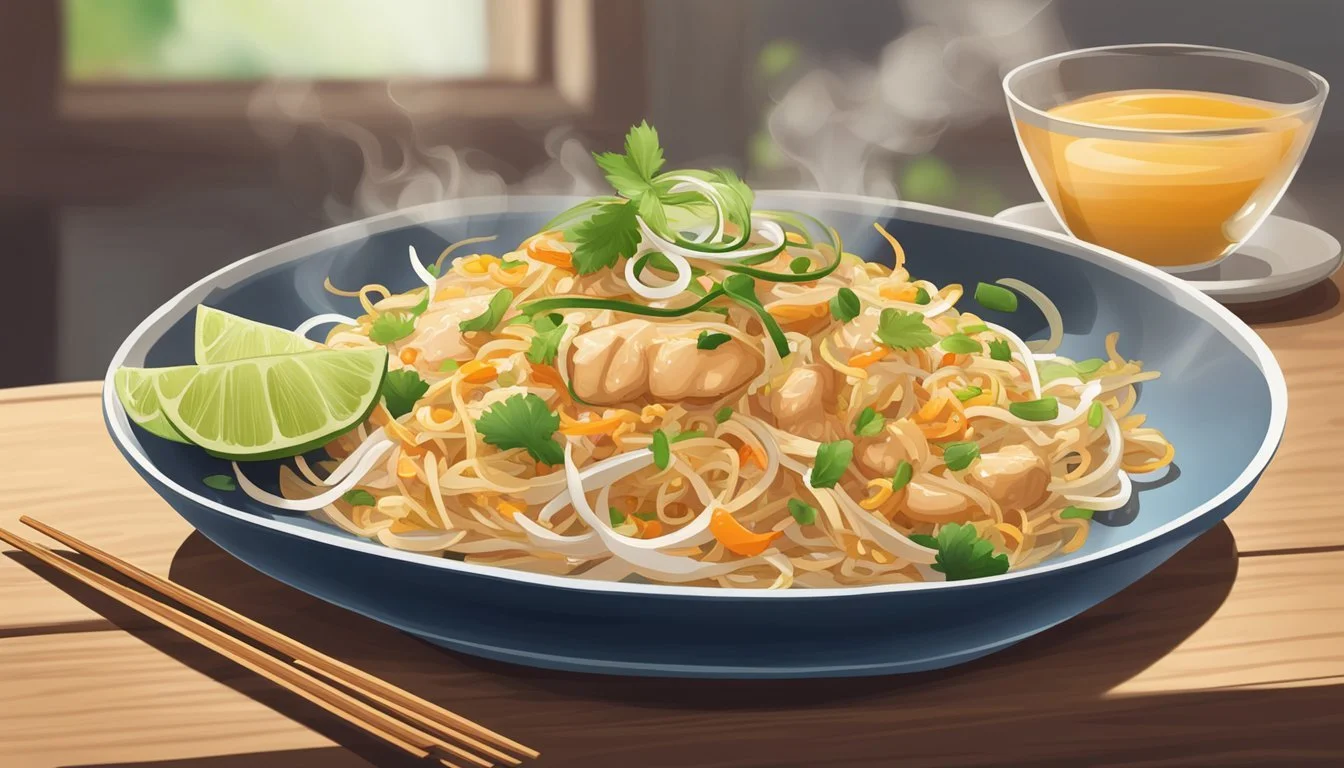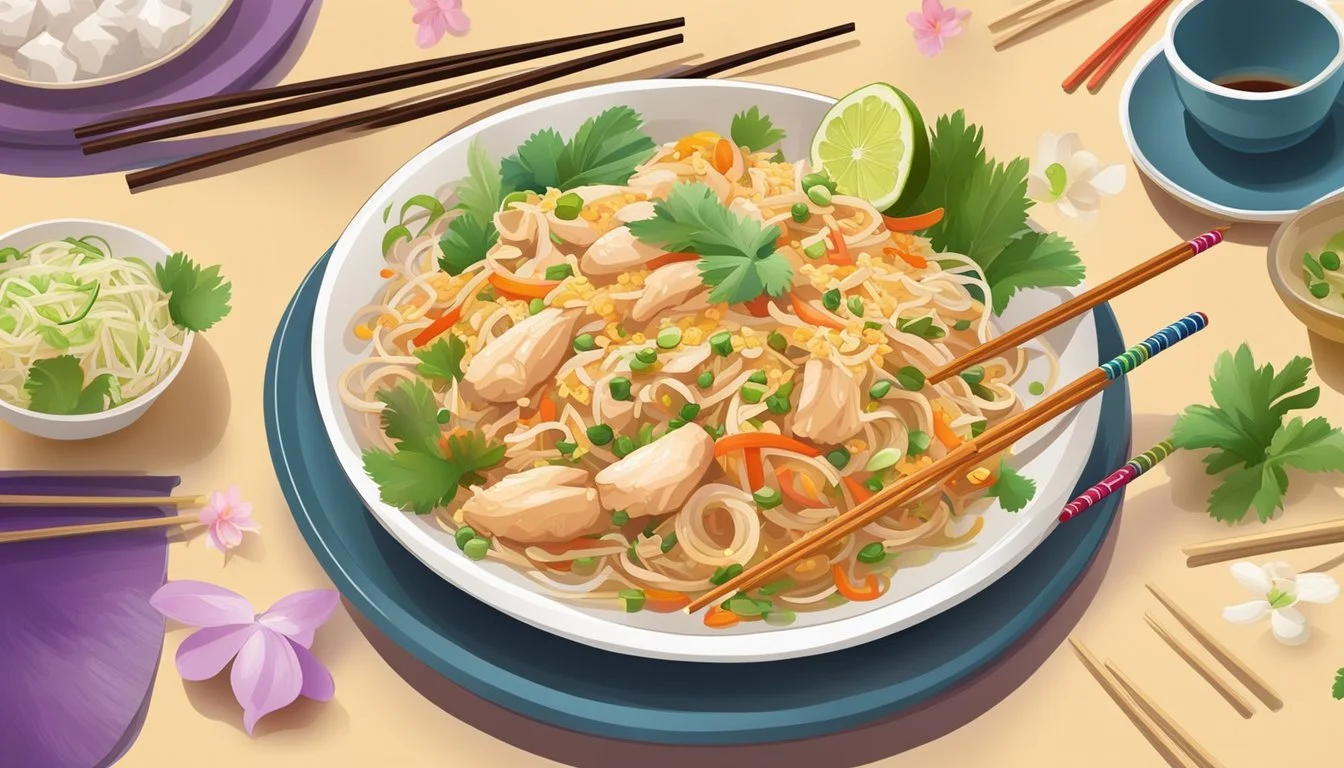How Long Does Chicken Pad Thai Last?
Shelf Life and Storage Tips
Chicken Pad Thai is a popular dish that many people enjoy both at restaurants and at home. When you make or purchase this flavorful meal, you might wonder how long you can safely keep those delicious leftovers. Properly stored Chicken Pad Thai can last in the refrigerator for around 3 to 4 days.
To ensure your Chicken Pad Thai remains fresh, it's essential to follow good storage practices. Once cooked, let the dish cool to room temperature before transferring it to an airtight container. This helps maintain its taste and texture, allowing you to enjoy it later without compromising on quality.
By following these simple guidelines, you can savor your Chicken Pad Thai even a few days after its initial preparation. For those who love meal prepping or simply can't get enough of this savory dish, understanding these storage tips will keep your leftovers safe and tasty.
Understanding Pad Thai
Pad Thai is a flavorful stir-fried noodle dish that combines a variety of textures and tastes. It typically features ingredients like rice noodles, chicken, tofu, and vegetables, and is known for its distinctive umami flavor.
Key Ingredients
Rice Noodles form the base of Pad Thai, providing the dish with its signature chewy texture. They are typically soaked rather than boiled to retain their unique consistency.
Chicken or Tofu is added as the main protein, absorbing the flavors from the sauce and other ingredients. Eggs are often scrambled and mixed in, adding richness and extra protein.
The sauce, usually made from Fish Sauce, tamarind paste, and a bit of sugar, gives Pad Thai its savory and slightly tangy profile. Lime wedges and Peanuts are used as garnishes, adding a fresh citrus note and a crunchy texture.
Nutritional Information
Pad Thai is a balanced meal but can vary in nutritional content based on the preparation and ingredients. A typical serving may contain:
Calories: Around 300-400
Carbohydrates: Predominantly from rice noodles, providing essential energy
Protein: From chicken, tofu, and eggs, contributing to about 20-25 grams
Fat: Typically from the oil used for cooking and peanuts, ranging from 10-15 grams
Fiber: Around 3-5 grams from vegetables and garnishes
Iron: Present in small amounts, particularly in tofu and leafy vegetables used in the dish
The Importance of Texture and Flavor
The success of Pad Thai heavily relies on its texture and flavor. The rice noodles should be soft yet slightly chewy. The umami from the fish sauce and the deep flavor of tamarind create a complex taste profile.
Vegetables provide a crunch, while nuts, particularly peanuts, add another layer of texture. The sauce is key to bringing the ingredients together, striking a balance between salty, sweet, and tangy flavors. Each ingredient plays a role in ensuring the dish is cohesive and enjoyable.
Correct preparation methods are essential to preserving these textures and flavors, ensuring an authentic and satisfying Pad Thai experience.
Proper Storage of Chicken Pad Thai
Maintaining the freshness of Chicken Pad Thai requires strict adherence to storage guidelines. Key considerations include proper refrigeration and the possibility of freezing to extend shelf life.
Optimal Refrigeration
Chicken Pad Thai should be stored in the refrigerator at a temperature below 40°F (4°C). This temperature inhibits bacterial growth and helps maintain the quality of the dish. Use airtight containers to prevent the dish from drying out and absorbing other refrigerator odors.
Storage Time: Generally, Chicken Pad Thai will last for 3-4 days in the refrigerator. Check for any signs of spoilage before consuming. Proper refrigeration includes dividing large portions into smaller containers to cool more quickly and evenly.
Freezing Chicken Pad Thai
For longer storage, Chicken Pad Thai can be frozen. Place the dish in airtight containers or heavy-duty freezer bags to prevent freezer burn. Label each container with the date to keep track of storage time. The dish can be frozen for up to two months.
Reheating Tips: When ready to eat, thaw the Pad Thai in the refrigerator overnight. Reheat thoroughly to an internal temperature of 165°F (74°C). Adding extra sauce or a splash of water during reheating can help maintain the dish’s moisture and flavor.
Safety and Shelf Life
Proper storage and awareness of spoilage signs are crucial for maximizing the shelf life of Chicken Pad Thai. The correct handling ensures that leftovers remain safe to eat and retain their quality.
Recognizing Spoilage
Detecting spoiled Chicken Pad Thai involves checking its smell, texture, and color.
Smell: Fresh Chicken Pad Thai should have a pleasant aroma from its mix of herbs and spices. An off or sour smell indicates spoilage.
Texture: Slimy or overly soft noodles and chicken can signal bacteria growth. Fresh Chicken Pad Thai maintains a firm and distinct texture.
Color: Any change from its original vibrant hues to a dull or discolored appearance suggests it's time to discard.
Ignoring these signs can lead to foodborne illness.
Recommended Consumption Timeframe
Chicken Pad Thai lasts 3-4 days in the refrigerator when stored in an airtight container. For optimal freshness, refrigerate immediately after cooking and keep the fridge temperature below 40°F (4°C).
Room Temperature: Avoid leaving Chicken Pad Thai at room temperature for more than 2 hours. Bacteria multiply rapidly between 40°F and 140°F (4°C to 60°C).
Refrigerator: Store leftovers in the refrigerator to extend shelf life. Always place them in a sealed container to maintain quality and reduce contamination.
Adhering to these guidelines ensures that Chicken Pad Thai stays fresh, flavorful, and safe to eat.
Reheating Chicken Pad Thai
Reheating Chicken Pad Thai is essential to retain its taste and texture. Using the right methods and paying attention to details can help avoid a cold or soggy dish.
Maintaining Quality During Reheating
Maintaining the quality of Chicken Pad Thai during reheating involves considering both the method and temperature. Using a low to medium heat prevents the dish from drying out. Adding a small amount of water or oil can help maintain the moisture, ensuring that the noodles do not become hard or overly dry.
Moisture: A splash of water or oil can keep the noodles soft.
Heat: Use low to medium heat to ensure even reheating.
Spreading: Spread the dish evenly in the pan or dish to promote uniform reheating.
These measures help in preserving the original flavors and textures, making the reheated dish enjoyable.
Reheating Techniques
Microwave:
Place the Chicken Pad Thai in a microwave-safe dish.
Add a splash of water to avoid drying out.
Cover the dish with a microwave-safe lid or wrap.
Reheat on medium power for 2-3 minutes, stirring halfway through.
Skillet/Stovetop:
Heat a small amount of oil in a skillet over medium heat.
Add the Chicken Pad Thai and spread it evenly.
Stir occasionally for 5-7 minutes until heated through.
Oven:
Preheat the oven to 350°F (175°C).
Lightly oil a casserole dish.
Evenly distribute the Chicken Pad Thai in the dish.
Cover with aluminum foil and reheat for 15-20 minutes until hot.
Each method offers specific advantages, ensuring that your Chicken Pad Thai remains delicious and satisfying. Adjusting the temperature and method as required can help achieve the best results.
Making Chicken Pad Thai at Home
To create a delicious Chicken Pad Thai at home, focus on the cooking process, achieving authentic flavors, and exploring alternative ingredients to suit dietary preferences and ingredient availability.
Step-by-Step Cooking Process
Cook the Noodles: Begin by soaking rice noodles according to the package instructions. Drain and keep them ready for stir-frying.
Cook the Chicken: Heat oil in a wok or large skillet over medium-high heat. Add chicken pieces and cook until they are no longer pink, usually 4-6 minutes. Remove the chicken from the pan and set it aside.
Scramble the Eggs: In the same pan, add a bit more oil if needed and pour in the beaten eggs. Scramble quickly and combine with the cooked chicken.
Make the Sauce: While cooking the chicken and eggs, prepare the Pad Thai sauce. Mix tamarind paste, fish sauce, soy sauce, and a touch of sugar or honey in a bowl.
Combine: Add the noodles, chicken, and sauce back to the pan. Stir-fry everything together until fully combined and heated through, about 2-3 minutes.
Crafting Authentic Flavor
Authentic ingredients are key to a delicious Pad Thai. Tamarind paste adds a unique tangy flavor, while fish sauce brings in the essential umami taste. Soy sauce or tamari can be used to add saltiness, with coconut aminos as a gluten-free option.
Using fresh bean sprouts, tofu, and green onions enhances the texture and traditional taste. Don't forget the crushed peanuts and lime wedges for garnish, which are classic components of an authentic Pad Thai dish.
Balancing sweet, salty, sour, and spicy elements is crucial for an authentic flavor profile.
Alternative Ingredients
For those with dietary restrictions or preferences, alternative ingredients can be used:
Gluten-Free: Use gluten-free soy sauce or tamari as a substitute for regular soy sauce.
Vegetarian: Replace chicken with tofu, ensuring it’s firm and properly drained.
Lower Sodium: Use coconut aminos as they are typically lower in sodium compared to regular soy sauce.
Experimenting with these alternatives allows everyone to enjoy a personalized version of Chicken Pad Thai without compromising on flavor or experience.
Diet and Variations
Chicken Pad Thai can be adapted in many ways to suit different dietary needs and preferences. Here are some ideas for healthier alternatives and vegetarian or vegan options that retain its flavorful appeal.
Healthier Alternatives
For a healthier Chicken Pad Thai, consider using zucchini noodles or shirataki noodles instead of traditional rice noodles. These options are lower in calories and carbohydrates. Another approach is to reduce the sodium content by opting for low-sodium soy sauce or coconut aminos.
Honey can be used in the sauce to provide sweetness, minimizing refined sugar intake. Lean protein sources like shrimp can be swapped for chicken to change up the dish while keeping it light. Adding extra vegetables such as bell peppers, carrots, and broccoli not only boosts the nutritional value but also enhances the flavor and texture variety.
Vegetarian and Vegan Options
For a vegetarian version, replace the chicken with tofu or additional vegetables like broccoli, snap peas, and bell peppers. Vegetarian Pad Thai typically uses the same sauce components, ensuring the same rich flavor. For vegans, ensure the sauce is made without fish sauce or any animal products.
Use an egg substitute such as a chickpea flour mixture or crumbled tofu for texture. Instead of meat, consider using seitan or tempeh, which offer a chewy texture similar to chicken. Lentils or beans can also be excellent plant-based protein sources.
Adjusting the components allows the dish to fit into various dietary frameworks while maintaining its delicious essence.
Serving Suggestions
Enhance the flavors of Chicken Pad Thai with garnishes and complementary dishes to create a well-rounded meal.
Garnishes and Toppings
Using various garnishes can elevate the taste and presentation of Chicken Pad Thai. Green onions, sliced thinly, provide a mild onion flavor and add a touch of color. Fresh lime wedges are essential for adding a zesty tang; squeezing lime juice over the dish can enhance its overall brightness.
Another vital topping is chopped peanuts, which introduce a crunchy texture and nutty flavor that pairs well with the savory elements of the dish. Sprinkling a few on top is both visually appealing and tastefully impactful.
Fresh cilantro leaves contribute an aromatic freshness that balances the richness of the noodles. Adding a handful of chopped cilantro offers a hint of citrusy notes. Combining these garnishes not only boosts flavor but also complements the nutrition and overall balance of the meal.
Pairing with Other Dishes
Chicken Pad Thai pairs well with various side dishes that provide complementary flavors. A popular choice is Thai Green Papaya Salad, which combines textures and tastes. Its tart and crunchy elements, including sliced green beans and chopped peanuts, align harmoniously with the dish's sweet and savory components.
Another excellent pairing is a bowl of Tom Yum Soup. The tangy and spicy broth of this soup contrasts nicely with the rich and creamy pad thai, creating a balanced meal.
Spring rolls, both fresh and fried, can be served to add a different texture and presentation. Fresh spring rolls are light and filled with herbs and vegetables, while fried spring rolls offer crunchiness. Together, these pairings create a diverse and satisfying dining experience.
Frequently Asked Questions
Q: How long does Chicken Pad Thai last in the refrigerator?
Chicken Pad Thai lasts 3 to 4 days in the refrigerator when stored in an airtight container.
Q: Can Chicken Pad Thai be frozen?
Yes, Chicken Pad Thai can be frozen. It is best to freeze it in an airtight container for up to 2-3 months.
Q: How should Chicken Pad Thai be reheated?
Reheat Chicken Pad Thai in a pan on medium heat. Stir occasionally and add extra sauce or liquid to prevent drying out.
Q: Does the type of protein affect Chicken Pad Thai's shelf life?
Yes, the type of protein can affect its shelf life. Chicken generally keeps well for 3 to 4 days when stored properly.
Q: What is the ideal fridge temperature for storing Chicken Pad Thai?
Maintain the refrigerator temperature below 40°F (4°C) to keep Chicken Pad Thai fresh.
Q: Can toppings and sauces be added before freezing?
No, it is recommended to add any desired toppings and sauces after reheating to ensure the best texture and flavor.
Q: Is it safe to eat Chicken Pad Thai after 4 days?
It is not recommended, as it may not be safe to consume. For the best quality and safety, consume within the advised timeframe.








